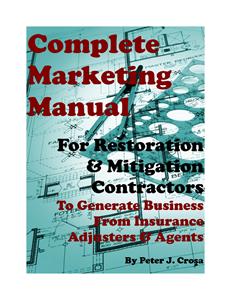Contractors: It's Time to Take a Stand

Editor’s Note:
This article was originally published in the Restoration Industry Association’s C&R Magazine. It is republished here with permission by the Restoration Industry Association (RIA).
“No payment will be provided for any services on this loss pursuant the failure to upload your documents within 45 days of job completion.”
This is the position taken by an insurance carrier on a recent mitigation claim wherein our company provided services. I won’t bore the reader with all the details on this claim. However, there are facts you should be aware of:
- The client called our firm directly for services and contracted directly with us for services.
- Several days after we were on-site and services were underway, the claim was “assigned” to our company via a third-party administrator (TPA).
- There was a delay in the document upload, some of which was our fault and some of which was due to a lack of response from the carrier.
- Regardless of the timeline, our firm never agreed to upload documents within a specified time frame at the risk of not being paid for services rendered.
As I read the email from the desk adjuster who was stationed over 1,000 miles away from the claim location, a series of questions flooded my mind. I suspect that most restorers in this predicament would have thoughts along the same lines.

“Seriously?”
“Your position is that ‘No payment will be provided for any services on this loss’?”
“Is this a lawful position?”
“Do we have to accept this?”
In my 25-plus years of property restoration experience, and tens of thousands of claims that I have been responsible for, this is certainly the most brazen approach I have seen by a carrier. Unfortunately, this is not an isolated case. The trend of hostility and bullying of restoration companies continues to escalate at an alarming rate. And even more concerning is that this trend seems to be begrudgingly accepted by restoration companies that are petrified to assert the rights or remedies available to them in situations like this.
This reluctance is sensible when you examine the sources of business volume for many restorers. I operate in a rural state where our customer base is primarily driven by word-of-mouth referrals, business relationships and top-of-mind awareness. I have the luxury of taking a firm stand and refusing to provide services to an insured, our client, for free.
For many companies, this is not their reality. The fear of retribution or being black-balled by either an insurance carrier or a TPA presents an untenable risk. So, they take it on the chin, vow to do a better job next time and write off this onerous experience as the “cost of doing business.”
While this approach is understandable, I challenge every restorer reading this to take a step back and ask yourself a couple of questions:
- Is the approach taken by the carrier ethically and legally defensible? I submit that aggressive tactics such as this one are essentially theft. If I told my insurance carrier that I’m not going to pay my premium because I prefer that they email the statement of what I owe them rather than send it in the mail, I expect that my policy would be canceled and I would be turned over to a collection agency for payment.
- If restorers accept this sort of outcome, what message is sent to the carrier? Are we telling insurance carriers that we will be beholden to their every stipulation and requirement, regardless of the sustainability to the property repair industry?
- Is there currently any compelling reason for any carrier to be held accountable for actions such as these in the current property claims ecosystem?
I am hopeful that we, as an industry, can begin to grapple with these questions in an objective and thoughtful manner. My thesis is this:
If restoration companies are unwilling to unite, advocate for sustainable claims practices and take a proactive approach with insurance carrier claims polices, then the restoration industry as we know it will cease to exist within a decade.
Currently, much of the industry voice has been abdicated to third-party administrators. This is not to say that I am anti-TPA. In fact, in my own experience that is related earlier in this article, the TPA was actually very helpful in resolving the issue. Nevertheless, our industry has allowed itself to be disproportionately represented by TPAs. In the competitive landscape of claims administration, the carrier dictates policies, which are not in the interest of the contractor, and the TPA accepts these, partially for the sake of growing their claim volume, and also due to a lack of voice or advocacy from the contractors within their networks. Contractors want more business from TPAs, and they are willing to do whatever it takes to protect or increase this volume, even when the requirements are not in their best interests.

So, what’s the answer? While the options available may, in some instances, be unappealing, remember you have viable options. These suggestions should be considered by all restoration companies who are striving to operate businesses that are profitable and sustainable. The suggestions I’m making are not exhaustive, but I hope that you are challenged to examine some of these options and subsequently take action.
1. Properly Identify the Customer
The insurance carrier is not our customer. Let me be clear; I do not advocate for a hostile relationship with carriers. They certainly have a vested interest in the claims that we work on. But let’s not forget, our primary responsibility for care should be toward our client, the insured, just as the carrier’s contractual obligation is to their insured, via the insurance policy (i.e., “the contract”). We use service agreements and contracts with our customers that clearly delineate their and our responsibilities and commitments. If you are currently, or considering, taking new business where you are required to use a contract that you have no control over, or one that essentially assigns away rights that have in your jurisdiction, please reconsider. Or at least have competent legal counsel review the agreement and advise you on the matter.
2. Value Your Integrity at All Costs
Last fall, RIA hosted a summit in Nashville with the single focus of TPA involvement in claims. One of the speakers, Rusty Amarante from Belfor, challenged the attendees to be mindful of the code of ethics that all RIA members agree to abide by. One of the specific elements of this code is as follows: “To operate in a manner consistent with ethical principles and sound business practice.”
In the current claims environment, this can be increasingly challenging, and I see it getting more and more difficult. Here’s a recent example: I had a discussion with the CEO of a large regional restoration company that had the opportunity to be on the ground floor of a pilot program for the largest insurance carrier in the United States. However, the carrier is requiring the TPA to mandate background checks demonstrating no criminal history be completed for every employee of every subcontractor that the restoration company hires. These background checks are fully comprehensive; they cover the entire adult history of every worker. As we all know, this requirement is, for all practical purposes, impossible to implement. Many companies find a workaround; they selectively screen a portion of their subs and try to fly under the radar. I am encouraged that the CEO of the restoration company, after a lot of difficult analysis, decided not to sign the agreement. He knew that he would have to compromise his integrity to agree to these stipulations, at potentially significant cost to his company. We need more restoration company owners to take decisions like this seriously and not compromise their integrity.
3. Use Lien Laws to Your Advantage
I am amazed that restoration contractors don’t use this tool to protect their interests on a regular basis. Again, this is not something that should be undertaken lightly, and you must understand the law in your county and/or state. Some TPAs may contractually require you to relinquish your lien rights. In some cases, this element of the contract may not be enforceable. Regardless, if you have agreed to relinquish your lien rights, please understand that you are significantly diminishing your ability to operate and protect your business. Many restorers anguish over the prospect of placing a lien on property they have worked on. Why is this? Again, if we understand who the customer is, this should be straightforward. Unfortunately, we often make the problem of the insured, as to who they have selected as a carrier, our problem.
4. Seek Professional Development
JP Morgan CEO Jamie Dimon has suggested that leaders of companies should commit 75-80 percent of their time to learning and self-development. Take an inventory of your time for the past few weeks. How much of that time was spent on growing your capabilities and skills? As an industry, we need to grow in our leadership skills and business acumen. Most of the training that owners have completed that is specifically focused on restoration practices is woefully outdated. This is one of the reasons that the RIA Board of Directors has oriented certain elements of our strategic plan toward the development of new advanced training and certifications. This fall, the Contents Loss Specialist (CLS) program is launching due to the tireless efforts of the volunteers who are totally committed to seeing our industry move forward. I wish this program had been available years ago. Please consider attending or sending one of your key people to this training program.
5. Unify with RIA
I think it’s regrettable that the largest event in our industry is a TPA conference. Do TPAs speak for our industry? Is this where we want policy and best practices to be developed? Obviously, these are rhetorical questions. But, seriously, restorers need to speak for restorers. Our voice is quiet at the moment. Let’s change this together. Sounds great, right? Well, it can only happen if you get involved. The only way for bad things to happen is for good people to do nothing. Currently, RIA has a task force working on objective improvements to the TPA landscape. However, their recommendations are going to require manpower and resources to be effectively deployed. The RIA Board of Directors is considering an allocation in 2019 for industry advocacy at the federal level. This will require resources to accomplish. We can’t do it without all restorers engaging and unifying, so please join us.
So, back to the story at the beginning of this article. The outcome was fine. We got paid. We moved on. But, I think the point is missed if we don’t work to ensure that this isn’t the new normal. The only way we can do this is to collectively grow a spine and operate good sustainable businesses.
Looking for a reprint of this article?
From high-res PDFs to custom plaques, order your copy today!








